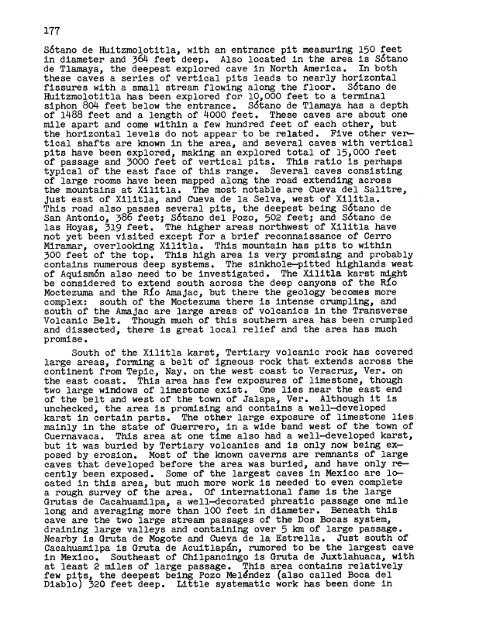17MB PDF - Association for Mexican Cave Studies
17MB PDF - Association for Mexican Cave Studies
17MB PDF - Association for Mexican Cave Studies
Create successful ePaper yourself
Turn your PDF publications into a flip-book with our unique Google optimized e-Paper software.
177S6tano de Huitzmolotitla, with an entrance pit measuring 150 feetin diameter and 364 feet deep. Also located in the area is S6tanode Tlamaya, the deepest explored cave in North America. In boththese caves a series of vertical pits leads to nearly horizontalfissures with a small stream flowing along the floor. S6tano deHuitzmolotitla has been explored <strong>for</strong> 10,000 feet to a terminalsiphon 804 feet below the entrance. S6tano de Tlamaya has a depthof 1488 feet and a length of 4000 feet. These caves are about onemile apart and come within a few hundred feet of each other, butthe horizontal levels do not appear to be related. Five other ve~tical shafts are known in the area, and several caves with verticalpits have been explored, making an explored total of 15,000 feetof passage and 3000 feet of vertical pits. This ratio is perhapstypical of the east face of this range. Several caves consistingof large rooms have been mapped along the road extending acrossthe mountains at Xilitla. The most notable are Cueva del Salitre,just east of Xilitla, and Cueva de la Selva, west of Xilitla.This road also Rasses several pits, the deepest being S6tano deSan Antonio, 386 feet; S6tano del Pozo, 502 feet; and S6tano delas Hoyas, 319 feet. The higher areas northwest of Xilitla havenot yet been visited except <strong>for</strong> a brief reconnaissance of CerroMiramar, overlooking Xilitla. This mountain has pits to within300 feet of the top. This high area is very promising and probablycontains numerous deep systems. The sinkhole-pitted highlands westof Aquism6n also need to be investigated. The Xilitla karst mightbe considered to extend south across the deep canyons of the RioMoctezuma and the RIo Amajac, but there the geology becomes morecomplex: south of the Moctezuma there is intense crumpling, andsouth of the Amajac are large areas of volcanics in the TransverseVolcanic Belt. Though much of this southern area has been crumpledand dissected, there is great local relief and the area has muchpromise.South of the Xilitla karst, Tertiary volcanic rock has coveredlarge areas, <strong>for</strong>ming a belt of igneous rock that extends across thecontinent from Tepic, Nay. on the west coast to Veracruz, Ver. onthe east coast. This area has few exposures of limestone, thoughtwo large windows of limestone exist. One lies near the east endof the belt and west of the town of Jalapa, Ver. Although it isunchecked, the area is promising and contains a well-developedkarst in certain parts. The other large exposure of limestone liesmainly in the state of Guerrero, in a wide band west of the town ofCuernavaca. This area at one time also had a well-developed karst,but it was buried by Tertiary volcanics and is only now being exposedby erosion. Most of the known caverns are remnants of largecaves that developed be<strong>for</strong>e the area was buried, and have only recentlybeen exposed. Some of the largest caves in Mexico are locatedin this area, but much more work is needed to even completea rough survey of the area. Of international fame is the largeGrutas de Cacahuamilpa, a well-decorated phreatic passage one milelong and averaging more than 100 feet in diameter. Beneath thiscave are the two large stream passages of the Dos Bocas system,draining large valleys and containing over 5 km of large passage.Nearby is Gruta de Mogote and Cueva de la Estrella. Just south ofCacahuamilpa is Gruta de Acuitlapan, rumored to be the largest cavein Mexico. Southeast of Chilpancingo is Gruta de Juxtlahuaca, withat least 2 miles of large passage. This area contains relativelyfew pits, the deepest being Pozo Mel~ndez (also called Boca delDiablo) 320 feet deep. Little systematic work has been done in
















